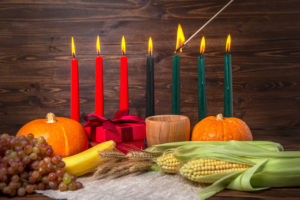
From Yule commemorations of ancient Germanic cultures to Jewish Hanukkah festivities, midwinter is often a time when people gather to feast, exchange gifts, and look forward to the upcoming spring. Kwanzaa is unique among these, and not just because of its recent creation. With its emphasis on heritage rather than religious faith, this new holiday has fascinating origins and purposes.
A Brief History of Kwanzaa
According to a PBS Black Culture Connection piece, Kwanzaa was first observed in 1966. The holiday was designed by Dr. Maulana Karenga, a scholar and activist heavily involved with the Black Power movement of the 1960s. Intended as a nonreligious pan-African holiday, Kwanzaa encourages black heritage and pride while honoring important values that uplift the community and promote positive growth and development. Karenga modeled the holiday after African “first-fruits” celebrations in which the initial products of the season’s harvest were offered to the gods.
Grounded in Unique and Meaningful Principles
The chief language for Kwanzaa’s symbols and principles is Swahili, chosen by Karenga because it’s spoken in multiple African countries. CNN’s Kendall Trammell explained in a December 2017 article that its name comes from the Swahili phrase “matunda ya kwanza,” which translates to “first fruits.” During this seven-day festival, celebrants meditate on seven principles known as the Nguzo Saba:
- Umoja: unity
- Kujichagulia: self-determination
- Ujima: collective responsibility
- Ujamaa: cooperative economics
- Nia: purpose
- Kuumba: creativity
- Imani: faith
Kwanzaa’s Symbols, Rituals, and Traditions
Kwanzaa is usually observed between December 26 and January 1. Daily commemorations involve the lighting of a candle inside a kinara. Named from a Swahili word translating as “candle holder,” the kinara bears seven candles that are collectively referred to as “mishumaa saba” and come in three colors: three red, one black, and three green.
When each candle is lit, celebrants contemplate one of the holiday’s seven principles. Taken from the Black Liberation flag, the candles’ colors have distinctive meanings of their own. Black stands for the African diaspora worldwide, while red represents the blood shed in their struggles and green symbolizes the rich African lands. Several other key items are used in Kwanzaa observances:
- Mazao, or fruits and vegetables representing the harvest
- Muhindi, ears of corn signifying children and the future
- The Kikombe cha Umoja, the unity cup for drinking and libations
- A mkeka, or a mat upon which the kinara, mazao, muhindi, and kikombe cha umoja are placed
Near the end of Kwanzaa, families and communities may come together to partake in Karamu Ya Imani. Often called Karamu for short, the phrase means “Feast of feats” in Swahili and usually falls on December 31. A Karamu gathering may include drumming music, the pouring of libations, and a lesson on that day’s principle, followed by a special dinner. Karamu fare typically includes traditional African, Caribbean, and South American recipes as well as soul food cuisine originating in the United States. Epicurious offers a sample Karamu menu, but dishes from all over the African diaspora are fair game.
Many Kwanzaa celebrants exchange gifts, referred to as “Zawadi,” on the final day. Given the unique nature of the holiday, many prefer to bestow homemade gifts that convey special meaning. However, those who aren’t craftily inclined or don’t possess culinary skill select commercially bought items that hold personal or cultural significance. Some examples include African-themed artwork, clothing, home décor items, jewelry, or books.
Harambee: The Call To Come Together
While many midwinter festivals are celebrated around the world, Kwanzaa is distinguished by its emphasis on cultural heritage and key values. When an elder speaks “Harambee” during Kwanzaa, that individual enjoins a household or group to come together. This call can also speak to the common human need for community, support, and shared meaning.

